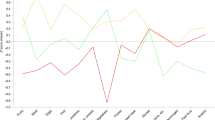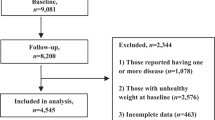Abstract
Objective: To analyse prevailing food patterns among Spanish children and young people and their relationship to sociodemographic and lifestyle factors.
Design: Cross-sectional population survey.
Setting: Population study. Data were collected at participants' home addresses.
Subjects: Random sample of the Spanish population aged 2–24 y (n=3534; 1629 boys and 1905 girls).
Interventions: Food consumption was assessed by means of a 24-h recall and a food frequency questionnaire. Sociodemographic and lifestyle related data were collected by specially designed questionnaires, previously pretested and validated. All the information was collected during a personal interview by trained dietitians. Data collection: May 1998–April 2000.
Results: Average consumption of fruit and vegetables was low. The youngest age group (2–5 y) showed the lowest proportions of inadequacy for the dairy group (P<0,001; χ2=39.11 boys; χ2=49.60 girls). Factor analysis identified five main components of dietary patterns. The ‘Snacky’ pattern was characterised by more frequent and higher consumption of bakery products (buns, cakes and biscuits), sweets, salted snacks and soft drinks. Higher intakes of fruit, vegetables and fish were associated to the ‘Healthy’ pattern. Children whose mother had a low level of education and those who spent more than 2 h daily watching TV were more likely to follow the ‘Snacky’ pattern. Girls were more likely to follow the ‘Healthy’ pattern, while children and young people whose mother had a lower level of education were less likely.
Conclusion: Results from this study highlight the importance of enhancing school-based and community-based actions to promote healthy eating and physical activity addressed to children and young people.
Sponsorship: This study was supported by Kellogg's Spain.
This is a preview of subscription content, access via your institution
Access options
Subscribe to this journal
Receive 12 print issues and online access
$259.00 per year
only $21.58 per issue
Buy this article
- Purchase on Springer Link
- Instant access to full article PDF
Prices may be subject to local taxes which are calculated during checkout
Similar content being viewed by others
References
Aranceta J (2001): Nutrición Comunitaria, 2a edición, pp 1–284. Barcelona: Masson.
Birch L & Fisher J (1998): Development of eating behaviours among children and adolescents. Pediatrics 101 (Suppl), 593–594.
Cusatis DC & Shannon BM (1996): Influences on adolescent eating behaviour. J. Adolesc. Health 18, 27–34.
Gonzales EN, Marshall JA, Heimendinger J, Crane LA & Neal WA (2002): Home and eating environments are associated with saturated fat intake in children in rural West Virginia. J. Am. Diet. Assoc. 102, 657–663.
Klepp KI (1994): Twelve year follow-up of a school-based health education programme. The Oslo Youth Study. Eur. Public Health 4, 195–200.
Lien N, Jacobs Jr DR & Klepp KI (2002): Exploring predictors of eating behaviour among adolescents by gender and socio-economic status. Public Health Nutr. 5, 671–681.
Lowry R, Kann L, Collins JL & Kolbe LJ (1996): The effect of socio-economic status on chronic disease risk behaviours among US adolescents. JAMA 276, 792–797.
Lowry R, Wechsler H, Gauska DA, Fulton JE & Kann L (2002): Television viewing and its associations with overweight, sedentary lifestyle and insufficient consumption of fruits and vegetables among US High School students: differences by race, ethnicity and gender. J. Sch. Health 72, 413–421.
Lytle LA (2002): Nutritional issues for adolescents. J. Am. Diet. Assoc. 102 (Suppl), S8–S12.
Mishra G, Ball K, Arbuckle J & Crawford D (2002): Dietary patterns of Australian adults and their association with socioeconomic status: results from the 1995 National Nutrition Survey. Eur. J. Clin. Nutr. 56, 687–693.
Munoz KA, Kreb-Smith SM, Ballard-Barbash R & Clevel and LE (1997): Food intakes of US children and adolescents compared with recommendations. Pediatrics 100, 323–329.
Neumark-Sztainer D, Story M, Resnick MD & Blum RW (1996): Correlates of inadequate fruit and vegetable consumption among adolescents. Prev. Med. 25, 497–505.
Neumark-Sztainer D, Story M, Dixon LB, Resnick MD & Blum RW (1997): Correlates of inadequate consumption of dairy products among adolescents. J. Nutr. Educ. 29, 12–20.
Nicklas TH (1995): Dietary studies of children: Bogalusa Heart Study experience. J. Am. Diet. Assoc. 95, 1127–1133.
Roos E, Lahelma E, Virtanen M, Prattala R & Pietinen P (1998): Gender, socioeconomic status and family status as determinants of food behaviour. Soc. Sci. Med. 46, 1519–1529.
Roos EB, Hirvonen T, Mikkila V, Karvonen S, Rimpela M (2001): Household educational level as a determinant of consumption of raw vegetables among male and female adolescents. Prev. Med. 33, 282–291.
Sanchez-Villegas A, Delgado-Rodríguez M, Martínez-Gonález MA & De Irala-Estevez J (2003): Gender, age, socio-demographic and lifestyle factors associated with major dietary patterns in the Spanish Project SUN (Seguimiento Universidad de Navarra). Eur. J. Clin. Nutr. 57, 285–292.
Schulze MB, Hoffman K, Kroke A & Boeing H (2003): An approach to construct simplified measures of dietary patterns from exploratory factor analysis. Br. J. Nutr. 89, 409–419.
Serra Majem L & Aranceta Bartrina J (eds) (2000): Desayuno y equilibrio alimentario. Estudio enKid, pp 1–226. Barcelona: Masson S.A.
Serra Majem L & Aranceta Bartrina J (eds) (2001): Obesidad Infantil y Juvenil. Estudio enKid. Vol. 2, pp 1–195. Barcelona: Masson S.A.
Serra Majem Ll, Aranceta Bartrina J, Pérez Rodrigo C, Moreno Esteban B, Tojo Sierra R, Delgado Rubio A & Grupo colaborativo AEP-SENC-SEEDO (2002): Criterios para la prevención de la obesidad infantil y juvenil: documento de consenso AEP-SENC-SEEDO. En: Curvas de referencia para la tipificación ponderal. Madrid: IM&C.
Serra-Majem Ll, Ribas Barba L, García Closas R, Pérez Rodrigo C, Peña Quintana L & Aranceta Bartrina J (2002): Hábitos alimentarios y consumo de alimentos en la población infantil y juvenil española (1998–2000): variables socioeconómicas y geográficas. In Alimentación infantil y juvenil. Estudio enKid. eds Serra Majem Ll, Aranceta Batrina J, pp 13–28. Barcelona: Masson.
Story M, Neumark-Sztainer D & French S (2002): Individual and environmental influences on adolescent eating behaviours. J. Am. Diet. Assoc. 102 (Suppl), S40–S51.
Zive MM, Frank-Spohrer GC, Sallis JF, McKenzie TL, Elder JP, Berry CC, Broyles SL & Nader PR (1998): Determinants of dietary intake in a sample of white and Mexican-American children. J. Am. Diet. Assoc. 98, 1282–1289.
Author information
Authors and Affiliations
Contributions
Guarantor: J Aranceta.
Contributors: JA has been the main contributor to this paper; CP-R and LR have been responsible for paper organisation and data analysis; Ll S-M and JA have been responsible for study design and methods.
Corresponding author
Rights and permissions
About this article
Cite this article
Aranceta, J., Pérez-Rodrigo, C., Ribas, L. et al. Sociodemographic and lifestyle determinants of food patterns in Spanish children and adolescents: the enKid study. Eur J Clin Nutr 57 (Suppl 1), S40–S44 (2003). https://doi.org/10.1038/sj.ejcn.1601813
Published:
Issue Date:
DOI: https://doi.org/10.1038/sj.ejcn.1601813
Keywords
This article is cited by
-
Dietary patterns are associated with attention-deficit/hyperactivity disorder (ADHD) symptoms among preschoolers in mainland China
European Journal of Clinical Nutrition (2018)
-
Mediation of psychosocial determinants in the relation between socio-economic status and adolescents’ diet quality
European Journal of Nutrition (2018)
-
Early factors related to carbohydrate and fat intake at 8 and 12 months: results from the EDEN mother–child cohort
European Journal of Clinical Nutrition (2017)
-
Dietary intake patterns of children aged 6 years and their association with socioeconomic and demographic characteristics, early feeding practices and body mass index
BMC Public Health (2016)
-
Early life determinants of dietary patterns in preschool children: Rhea mother–child cohort, Crete, Greece
European Journal of Clinical Nutrition (2016)



